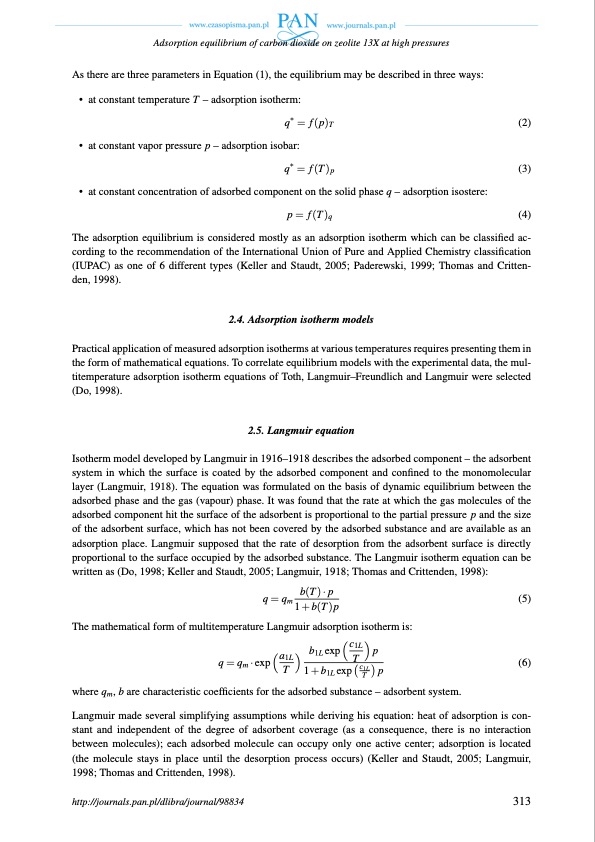
PDF Publication Title:
Text from PDF Page: 005
Adsorption equilibrium of carbon dioxide on zeolite 13X at high pressures As there are three parameters in Equation (1), the equilibrium may be described in three ways: • at constant temperature T – adsorption isotherm: q∗ = f(p)T (2) • at constant vapor pressure p – adsorption isobar: q∗ = f(T)p (3) • at constant concentration of adsorbed component on the solid phase q – adsorption isostere: p= f(T)q (4) The adsorption equilibrium is considered mostly as an adsorption isotherm which can be classified ac- cording to the recommendation of the International Union of Pure and Applied Chemistry classification (IUPAC) as one of 6 different types (Keller and Staudt, 2005; Paderewski, 1999; Thomas and Critten- den, 1998). 2.4. Adsorption isotherm models Practical application of measured adsorption isotherms at various temperatures requires presenting them in the form of mathematical equations. To correlate equilibrium models with the experimental data, the mul- titemperature adsorption isotherm equations of Toth, Langmuir–Freundlich and Langmuir were selected (Do, 1998). 2.5. Langmuir equation Isotherm model developed by Langmuir in 1916–1918 describes the adsorbed component – the adsorbent system in which the surface is coated by the adsorbed component and confined to the monomolecular layer (Langmuir, 1918). The equation was formulated on the basis of dynamic equilibrium between the adsorbed phase and the gas (vapour) phase. It was found that the rate at which the gas molecules of the adsorbed component hit the surface of the adsorbent is proportional to the partial pressure p and the size of the adsorbent surface, which has not been covered by the adsorbed substance and are available as an adsorption place. Langmuir supposed that the rate of desorption from the adsorbent surface is directly proportional to the surface occupied by the adsorbed substance. The Langmuir isotherm equation can be written as (Do, 1998; Keller and Staudt, 2005; Langmuir, 1918; Thomas and Crittenden, 1998): q=q b(T)·p (5) m 1 + b(T ) p The mathematical form of multitemperature Langmuir adsorption isotherm is: ( c1L ) (a1L) b1Lexp T p q = qm · exp T 1 + b1L exp ( c1L ) p (6) T where qm, b are characteristic coefficients for the adsorbed substance – adsorbent system. Langmuir made several simplifying assumptions while deriving his equation: heat of adsorption is con- stant and independent of the degree of adsorbent coverage (as a consequence, there is no interaction between molecules); each adsorbed molecule can occupy only one active center; adsorption is located (the molecule stays in place until the desorption process occurs) (Keller and Staudt, 2005; Langmuir, 1998; Thomas and Crittenden, 1998). http://journals.pan.pl/dlibra/journal/98834 313PDF Image | ADSORPTION EQUILIBRIUM OF CARBON DIOXIDE ON ZEOLITE

PDF Search Title:
ADSORPTION EQUILIBRIUM OF CARBON DIOXIDE ON ZEOLITEOriginal File Name Searched:
Adsorption_equilibrium_of_carbon_di.pdfDIY PDF Search: Google It | Yahoo | Bing
CO2 Organic Rankine Cycle Experimenter Platform The supercritical CO2 phase change system is both a heat pump and organic rankine cycle which can be used for those purposes and as a supercritical extractor for advanced subcritical and supercritical extraction technology. Uses include producing nanoparticles, precious metal CO2 extraction, lithium battery recycling, and other applications... More Info
Heat Pumps CO2 ORC Heat Pump System Platform More Info
| CONTACT TEL: 608-238-6001 Email: greg@infinityturbine.com | RSS | AMP |